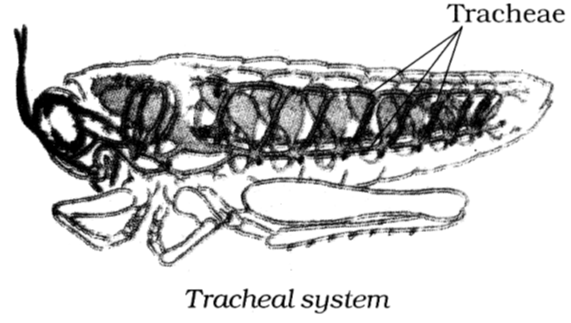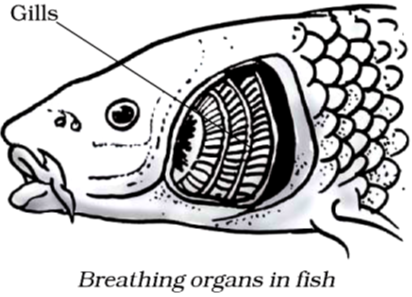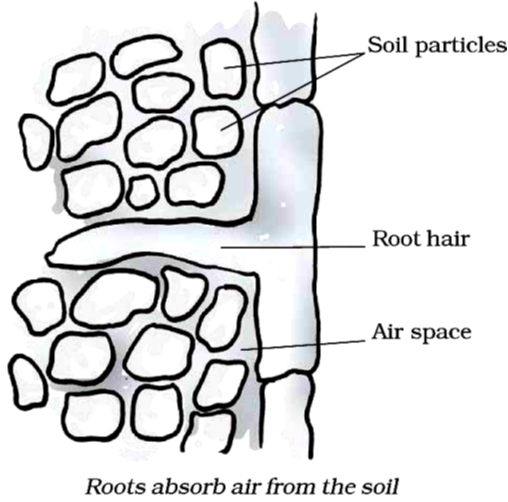Why Do We Respire?
- Books Name
- CBSE Class 7 Science Book
- Publication
- Param Publication
- Course
- CBSE Class 7
- Subject
- Science
WHY DO WE RESIRE
The process of oxidation of food into carbon dioxide and water to produce energy is called respiration. On the basis of presence of oxygen respiration is of two types :
(a) Aerobic respiration : When break-down of glucose occurs with the use of O2 , it is called aerobic respiration. In this process there is complete breakdown of food, so maximum production of energy.
![]()
(b) Anaerobic respiration : When breakdown of glucose occurs in lack or limited supply of O2 is called anaerobic respiration.

During heavy exercise, when the supply of oxygen to our muscle cell is insufficient, food breakdown occurs by anaerobic respiration.

TYPES OF RESPIRATION
There are two types of respiration – aerobic and anaerobic respiration.
1. Aerobic Respiration : When the breakdown of food substances (like glucose) takes place in the presence of oxygen with the release of a large amount of energy, it is called aerobic respiration. In this process, carbon dioxide and water are released as waste products.
The overall equation for aerobic respiration is:
![]()
Most animals including humans and green plants respire aerobically.
2. Anaerobic Respiration : Anaerobic respiration is the breakdown of food substances with the release of a small amount of energy in the absence of oxygen. It occurs in certain organisms like yeast and some bacteria. These organisms are called anaerobes.
In th absence of oxygen, glucose breaks down into alcohol and carbon dioxide with the release of comparatively less energy.
The equation for anaerobic respiration is:
![]()
Breathing
- Books Name
- CBSE Class 7 Science Book
- Publication
- Param Publication
- Course
- CBSE Class 7
- Subject
- Science
BREATHING
• Exchange of gases or taking in O2 and giving out CO2 with the help of respiratory organs is called breathing.
• The taking in of air rich in oxygen is called inhalation and giving out CO2 rich air is called exhalation.
• It is a continuous process which goes on all the time and throughout the life of an organism.
• The number of times a person breathes in a minute is called the breathing rate.
• Normal breathing of adult human beings at rest is about 15-18 per min. But it can change according to requirement of O2 by the body.
• Thus, whenever a person needs extra energy breathing rate increases.
• So, during heavy exercise, the breathing rate can increase upto 25 times per minute and also we take deep breaths to inhale more oxygen.
• As a result more oxygen is supplied to our cells.
• So speeds up the breakdown of food and more energy is released.
• That is the cause we feel hungry after a physical activity.
Breathing in Other Animals
- Books Name
- CBSE Class 7 Science Book
- Publication
- Param Publication
- Course
- CBSE Class 7
- Subject
- Science
Breathing in Other Animals
• Animals such as elephants, lions, cows, goats, frogs, lizards, snakes, birds have lungs in their chest cavities like the human beings.
• Respiration in insects: A cockroach has small openings on the sides of its body. Other insects also have similar openings. These openings are called spiracles. Insects have a network of air tubes called tracheae for gas exchange. This type of respiration is called tracheal respiration. Oxygen rich air rushes through spiracles into the tracheal tubes, diffuses into the body tissue, and reaches every cell of the body. Similarly, carbon dioxide from the cells goes into the tracheal tubes and moves out through spiracles. These air tubes or tracheae are found only in insects and not in any other group of animals.

• Respiration in Earthworm: Earthworms breathe through their skin. This is called cutaneous respiration.The skin of an earthworm feels moist and slimy on touching. Gases can easily pass through them. Though frogs have pair of lungs like human beings, they can also breathe through their skin, which is moist and slippery by the process of diffusion.
Breathing Under Water
- Books Name
- CBSE Class 7 Science Book
- Publication
- Param Publication
- Course
- CBSE Class 7
- Subject
- Science
Breathing Under Water

Gills in fish help them to use oxygen dissolved in water. Gills are projections of the skin. Gills help in breathing. Gills are well supplied with blood vessels for exchange of gases. But breathing in water is quite difficult as water is dense and having less dissolved oxygen than air.
Do Plants Also Respire?
- Books Name
- CBSE Class 7 Science Book
- Publication
- Param Publication
- Course
- CBSE Class 7
- Subject
- Science
Do Plants Also Respire?
They also take in oxygen from the air and give out carbon dioxide. In the cells oxygen is used to break down glucose into carbon dioxide and water as in other organisms.
In plants each part can independently take in oxygen from the air and give out carbon dioxide. The leaves of the plants have tiny pores called stomata for exchange of oxygen and carbon dioxide. Like all other living cells of the plants, the root cells also need oxygen to generate energy. Roots take up air from the air spaces present between the soil particles with the help of root hairs. Lenticels in old stems and general surface of roots help in respiration. Lenticells in old stem and general surface of roots help in respiration.

 Grow Career Publication
Grow Career Publication
 Param Publication
Param Publication
